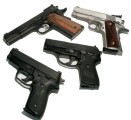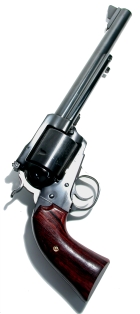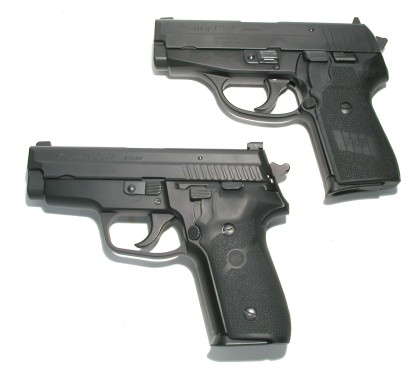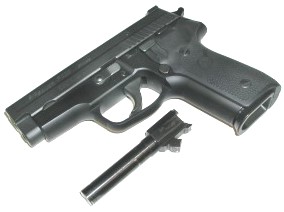 When it comes to handguns for self defense, I have been the proverbial blank slate. I’ve owned a good number of single and double action revolvers and various autoloaders for recreational purposes, and some more specialized single shot handguns specifically for hunting or handload development, but not much in the way of firearms for self defense. My time in the Air Force left me with the understanding weapons came in 1,000 lb increments and the only gun I ever carried, an air weight Chief Special snub nose, produced enough muzzle blast to start a forest fire. My wife and I had taken a firearms’ self defense course a couple of years ago, however, after popping the instructor in the head with my Colt auto’s recoil spring, several times, during the mandatory firearm disassembly phase, my wife was allowed to matriculate while I was rerouted to the “special class”.
When it comes to handguns for self defense, I have been the proverbial blank slate. I’ve owned a good number of single and double action revolvers and various autoloaders for recreational purposes, and some more specialized single shot handguns specifically for hunting or handload development, but not much in the way of firearms for self defense. My time in the Air Force left me with the understanding weapons came in 1,000 lb increments and the only gun I ever carried, an air weight Chief Special snub nose, produced enough muzzle blast to start a forest fire. My wife and I had taken a firearms’ self defense course a couple of years ago, however, after popping the instructor in the head with my Colt auto’s recoil spring, several times, during the mandatory firearm disassembly phase, my wife was allowed to matriculate while I was rerouted to the “special class”.
A recent move to a rural area, with a home constructed on wooded acreage, brought about a need for us to consider a handgun specifically for self defense. My wife and I decided we would try to find something suitable for the both of us, a firearm that could be kept in the home as well as carried concealed while outdoors. Selecting a rifle for recreational or competitive shooting takes time and effort, there are many brands and models and there are many applications, but selection of a handgun for self defense was obviously more critical where the appropriateness of choice could literally mean someone’s life or death. So we set aside all of our preconceived notions and began by developing a list of areas we felt should be considered. We, one of us more than the other, felt an objective baseline would be a good way to avoid having us end up with something big and fun to talk about, but of little use our intended purpose. We came up with a short list of five qualifications:
1. Easy to shoot accurately.
2. Reliable in operation
3. Good stopping power
4. Compact and light weight.
5. Low maintenance
 Revolvers were eliminated at the onset. The idea of manually cocking a firearm before each shot did not seem reasonable, outside of events and purposes with an underlying theme of nostalgia. If the design were superior, Glock would be releasing new revolvers, and Colt would still be pushing out those SAA’s under government contract. We did not want to deal with revolver mechanical assembly maintenance and neither of us cared for a double action revolver trigger pull. Eliminating revolvers narrowed handgun choices and also cartridge selection; the latter not necessarily a good thing sine there are lots of exception cartridges that traditionally find a home in revolvers; 45 Colt, 44 Mag, 357 Mag, 41 Mag to name a few.
Revolvers were eliminated at the onset. The idea of manually cocking a firearm before each shot did not seem reasonable, outside of events and purposes with an underlying theme of nostalgia. If the design were superior, Glock would be releasing new revolvers, and Colt would still be pushing out those SAA’s under government contract. We did not want to deal with revolver mechanical assembly maintenance and neither of us cared for a double action revolver trigger pull. Eliminating revolvers narrowed handgun choices and also cartridge selection; the latter not necessarily a good thing sine there are lots of exception cartridges that traditionally find a home in revolvers; 45 Colt, 44 Mag, 357 Mag, 41 Mag to name a few.
Cartridge selection for defense purposes is rife with controversy and steeped in forensic sciences. I set aside all of my theoretical ballistic calculators, Hatcher and federal government computer man studies and relied on the results of field data collected from law enforcement and published by Evan Marshall, “Stopping Power: A Practical Analysis of the Latest Handgun Ammunition” defines stop shots in paraphrase as a shot to the body, not the head, neck or extremities, that stops the attack and causes the assailant to run no more than 10 feet before collapsing. We felt this type of record keeping would eliminate issues of poor training, missed shots and grazing strikes and focus on the terminal ballistics within a probably scenario and the effectiveness of the round, not the gun or shooter.
 Keeping in mind that the effectiveness indicated for these cartridges are very much specific load dependent, we concluded we would want a gun chambered for the following, based on the indicated one shot stop percentage: 45 ACP 96%, 40 S&W 94% and 357 SIG – 91%. Both the 45 ACP and 40 S&W rounds were based on the use of the Remington Golden Saber bullet, a component that cannot be used with the 357 SIG due to the cartridges short neck and limited bullet contact surface. We had a good deal of positive experience with the 45 ACP, saw the 40 S&W as a lesser power and lower recoil compromise, and the 357 SIG as a proven and popular law enforcement selection that required our further examination. From a purely stopping power effectiveness, the choices were clear, but it was time to bring in two of our other leading selection factors; easy to shoot accurately and reliable in operation, neither were considered within the study. Within this range of cartridges, we scanned manufacture’s catalogues, visited web sites for detailed specifications and made a list of the firearms we felt would meet our requirements. We took our list, and handguns appearing on the list we already owned, and headed for a local indoor range where we were able to rent the balance of the firearms and gain live fire experience with each.
Keeping in mind that the effectiveness indicated for these cartridges are very much specific load dependent, we concluded we would want a gun chambered for the following, based on the indicated one shot stop percentage: 45 ACP 96%, 40 S&W 94% and 357 SIG – 91%. Both the 45 ACP and 40 S&W rounds were based on the use of the Remington Golden Saber bullet, a component that cannot be used with the 357 SIG due to the cartridges short neck and limited bullet contact surface. We had a good deal of positive experience with the 45 ACP, saw the 40 S&W as a lesser power and lower recoil compromise, and the 357 SIG as a proven and popular law enforcement selection that required our further examination. From a purely stopping power effectiveness, the choices were clear, but it was time to bring in two of our other leading selection factors; easy to shoot accurately and reliable in operation, neither were considered within the study. Within this range of cartridges, we scanned manufacture’s catalogues, visited web sites for detailed specifications and made a list of the firearms we felt would meet our requirements. We took our list, and handguns appearing on the list we already owned, and headed for a local indoor range where we were able to rent the balance of the firearms and gain live fire experience with each.
We tried various firearms from Beretta, Browning, Colt, Glock, H&K, Kimber, Ruger, S&W, SIG, and Springfield Armory. Several low cost autos were eliminated at the rental counter over issues of poor fit and finish, and production materials. After some live fire, we eliminated Glock for an undesirable trigger pull, overall construction and feel. We then eliminated all polymer framed guns because they felt unbalanced and uncomfortable in use. We eliminated all double action only firearms as difficult to shoot accurately with a heavy and/or spongy trigger pull. We eliminated all firearms that were unnecessarily heavy, fell into a large envelope, or were too large in the grip area; perhaps designs that were a carry over from the old double stack 9mm days. With the decision to stay with a short length, short barrel pistol, we also dropped the 45 ACP. We determined that the larger capacity case 45 ACP with defense loads gave away too much performance in short barrel versions. Between the 40 S&W and the 357 SIG, we were able to consistently get better accuracy out of the SIG cartridge, which made the 357 SIG our cartridge of choice.
I am sure the preceding paragraph contradicts any number of experienced and credible people, based on the well known success of certain brands and types of handguns we dismissed. We specifically stayed away from message boards and newsgroup advice, because a gun for this purpose has to be right for the shooter, not the person making a suggestion. While there are lots of great firearms from all of the noted firearm manufacturers, they are just not for us. For recreational shooting, for wanting an interesting piece of machinery, there are a number of these guns we do own, or would own, but not for this purpose.
 While we were able to reach agreement on a common cartridge, we decided on two different SIG pistols, a P229 and a P239. The P229 holds 10 rounds (12 for law enforcement), the P239 holds 7, which equated to a ¾” difference in grip circumference; 6” and 5 ¼” respectively and all the difference in the world for comfortable shooting.
While we were able to reach agreement on a common cartridge, we decided on two different SIG pistols, a P229 and a P239. The P229 holds 10 rounds (12 for law enforcement), the P239 holds 7, which equated to a ¾” difference in grip circumference; 6” and 5 ¼” respectively and all the difference in the world for comfortable shooting.
Compared to our original 5 points of selection –
1. With a distance of 1 ¼” from bore centerline to web of hand, and about 18° – 20° off perpendicular to grip angle, the P229 and P239 feel very much like a Colt Commander and Colt Officer’s Model respectively in recoil. Alloy frames and steel upper assemblies make the SIGs are 5 ounces lighter than their Colt all steel counterparts, however, based on a good deal of 1911 type shooting experience, they still felt familiar which contributed to making them easy to shoot. The 357 SIG is accurate and consistent, 2” – 2 ½” 25 yard groups from a rest.
2. I’ve had 1911 type pistols occasionally stove pipe or fail to chamber a round, this never happened with either SIG. Operation was very smooth, cycling was very positive and solid; there was nothing sloppy about the operation of the guns. We’ve now had thousands of rounds through these pistols without a failure. Like the 1911 type pistol, recoil springs are available in a variety of weights to tune SIGs for ammunition type extremes. The controls are well placed, easy to reach and positive in operation.
3. Based on ballistics for the round, federal and state police assessment reports, and some local testing on small game, the 357 SIG has excellent stopping power. Our defense handload is base on a 125 grain Speer Gold Dot at 1,400+ fps, however, we have also had good results with Hornady HP-XTP bullets. At any reasonable defense shooting range, they expand well and hold together. As indicated earlier, Golden Saber bullets are not compatible with this round.
4. Both guns are compact and relatively light, while retaining a solid feel and a long enough grip for comfortable shooting. Both share about the same 1”+ wide slide with as a 1911 type pistol. All of these guns are all a shade over 5” high, however, with the absence of a grip safety the SIGs are short; 7 ¼” for the 3.9” barrel P229 and 6 ¾” for the 3.6” barrel P239. The SIGs are cleaner on the outside with fewer projecting mechanical parts to get snagged on clothing than 1911 design autos.
5. The SIGs with slides machined from a solid block of stainless steel and alloy frames have a non-reflective Nitron™ finish, a bonded epoxy resin. The finish seems to have some level of lubricity and does not easily scratch or wear and is perfect for defense purposes where shinny guns may not be first choice. SIGs have the expected recoil and magazine springs that require minimal attention, and perhaps more stamped steel small parts than found on a 1911 type, but our guns have remained tight and free of malfunction.
All things SIG are not perfect, some things are just different and some are really nifty features. The standard contrast “apple on the stick” 2 dot sights are hard to find even in good lighting, the three dot system is better, the small SIG tritium night sights are less than exciting. We installed Trijicon 3 dot sights on our guns. All sights are windage adjustable, not elevation. There are aftermarket adjustable sights and there are a number of other types of site systems.
 The SIGs have interchangeable barrels allowing the owner to switch between 357 SIG and 40 S&W cartridges. The P229 magazine works with both 357 SIG and 40 S&W, the P239 requires different magazines in addition to the barrel change for each of the two cartridges. 9mm versions of these firearms cannot be converted to either of these cartridges. A barrel change takes easily less than 30 seconds. SIG sells all of these parts as accessories, but third party vendors also make match grade barrels. For most application, however, a barrel of this type would be unnecessary and would not improve accuracy or reliability. The SIG does not incorporate a barrel bushing in the slide assembly, they do use a one piece full length guide rod for the recoil spring.
The SIGs have interchangeable barrels allowing the owner to switch between 357 SIG and 40 S&W cartridges. The P229 magazine works with both 357 SIG and 40 S&W, the P239 requires different magazines in addition to the barrel change for each of the two cartridges. 9mm versions of these firearms cannot be converted to either of these cartridges. A barrel change takes easily less than 30 seconds. SIG sells all of these parts as accessories, but third party vendors also make match grade barrels. For most application, however, a barrel of this type would be unnecessary and would not improve accuracy or reliability. The SIG does not incorporate a barrel bushing in the slide assembly, they do use a one piece full length guide rod for the recoil spring.
 Both model SIGs are double/single action. A round can be chambered and the gun’s decocking lever, located just above the Mag release button, can be used to safely lower the hammer. The gun’s double action allows firing this first round without manually cocking the hammer or cycling the gun. Subsequent rounds are fired single action. Specification double action pull is about 10 lbs, single action is about 4 ½ lbs; approximately 11 ½ lbs and 4 ½ lbs for our guns. Decocked, the trigger is about a 3” reach from the back of the gun’s grip, 2 ½” cocked. By comparison, a 1911 type reach is approximately 3”. The photo on the left is a pretty good illustration of single action, top, and double action, bottom, trigger position. For shooters with smaller hands, or working with gloves, SIG offers an owner installable short trigger.
Both model SIGs are double/single action. A round can be chambered and the gun’s decocking lever, located just above the Mag release button, can be used to safely lower the hammer. The gun’s double action allows firing this first round without manually cocking the hammer or cycling the gun. Subsequent rounds are fired single action. Specification double action pull is about 10 lbs, single action is about 4 ½ lbs; approximately 11 ½ lbs and 4 ½ lbs for our guns. Decocked, the trigger is about a 3” reach from the back of the gun’s grip, 2 ½” cocked. By comparison, a 1911 type reach is approximately 3”. The photo on the left is a pretty good illustration of single action, top, and double action, bottom, trigger position. For shooters with smaller hands, or working with gloves, SIG offers an owner installable short trigger.
I do not like the plastic grips SIG installs at the factory, they have too slick of a finish. I installed a set of soft Hogue grips that solved the problem. My wife liked the narrow grips as supplied by the factory and those remained in place on the P239. I have also tried wood grips on the P229; they look good, but add too much width and are also pretty surface slick. For left handed shooters, the magazine release is reversible. The rest of the controls are well placed and easy to operate. Anyone spending time with a one piece recoil spring rod 1911 with a tight barrel bushing and heavy recoil spring would find the SIG much more cooperative during field level assembly and disassembly.
|
SIG Overview |
||
| Specification | P229 |
P239 |
| Caliber | 9 mm, 357 SIG, 40 S&W | 9mm, 357 SIG, .40 S&W |
| Overall Length | 7.1” | 6.6” |
| Overall Height | 5.4” | 5.2” |
| Overall Width | 1.5” | 1.2″ |
| Barrel Length | 3.9” | 3.6” |
| Weight | 31.1 oz | 29.8 oz |
| Sight Radius | 5.7″ | 5.2” |
| Capacity | 10 (12 LE) | 7 |
| Finishes | Nitron®, Two-Tone | Nitron®, Two-Tone |
If you have read this and are wondering what happened to the 357 Mag revolver that would have been your first choice, or a pump scatter gun with an 18″ barrel, or that $2,500 H&K special forces piece with compensator; those selection just didn’t work for us, but they may very well work for you. The question, “What gun should I buy for self defense?” has no correct answer from external sources without the person asking the question being front and center and gathering experience to test any responses. I absolutely am not endorsing the SIG as a handgun of choice for all others, but I am suggesting a similar process for assessment and selection.
Thanks,
Joe

Email Notification